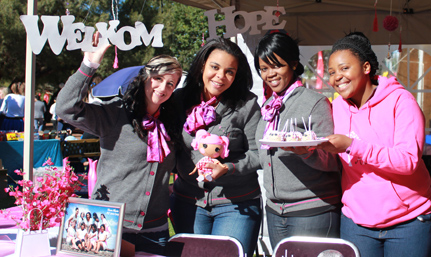|
 |
|
08 May 2013
Photo: Lelanie de Wet |
The procession – comprising of Prof Jonathan Jansen and the Deans of all the UFS faculties – stately entered a packed Callie Human Centre on Saturday morning 4 May 2013. As everyone took their seats, all the lights were abruptly cut, leaving the hall in a stunned silence. Suddenly brilliant beams of green, blue and red lights cut through the dark, exploding into a spectacular laser show.
Open Day 2013 on the Bloemfontein Campus was officially under way.
The audience of parents and prospective students were awe-struck by a transfixing electric guitar performance, dancers lit up by LED suits, pulsing music and finally Corneil Muller singing to the accompaniment of Prof Jansen behind the piano.
Vice-Chancellor and Rector, Prof Jansen immediately made attendees from across all nine provinces, Namibia, Lesotho and several other countries feel at home and embraced by the university. During his welcoming address, Prof Jansen referred to the fact that Kovsies places the bar high when it comes to achievement. “We expect more of our students,” he said. “Passing is not important, passing wéll is important.” He stressed that at the university we teach students to be decent, to be exceptional people. “We place a high premium on being an outstanding human being.” He went on to say that our students are better than the previous generation – they do not carry the baggage of the old.
Prof Jansen also communicated the university’s commitment to developing leaders with an understanding of the world. This is why the university afford students the opportunity, amongst other things, to study abroad. Students have access to a wide variety of organisations and the privilege to have access to leaders who they can converse with. Kovsies strives to produce leaders, not only in the community, but on a global platform.
To demonstrate this last point, top Kovsie achievers joined Prof Jansen on stage to relay their stories of perseverance, courage and success. Included among these stars, were athlete Danél Prinsloo; Varsity Cup Player that Rocks 2013 Oupa Mohoje; DW Bester, a Rhodes Scholar currently studying at Oxford University in the United Kingdom; and Jurie Swart, who ranked under the top five in the 2012 International Graduate Architecture Student Design competition.
The residences pulled out all stops when it came to the presentation of their individual stalls. The gardens in front of the Main Building burst with colour, sound, dancing and laughter as the residences competed to draw the most visitors. The faculties also opened their doors for a glimpse at the exciting opportunities awaiting prospective students.
A record amount of visitors went home with the words of Rudi Buys, Dean of Student Affairs, inscribed in their minds summing up what the UFS is all about: “Where a sense of community matters more than the colour of your skin.”